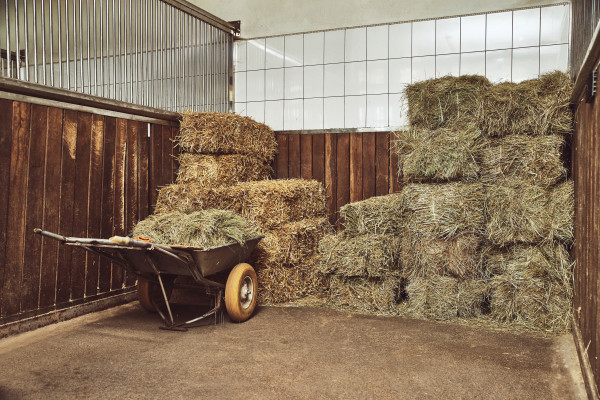You can tell a lot about hay just by looking at it, feeling it and smelling it. When assessing the quality of hay, consider the following factors:

Type of plant. Grass hays, such as timothy or orchardgrass, provide sound basic nutrition. The higher the concentration of legumes, such as alfalfa or clover, the higher the energy content (too much legume hay can cause nutritional imbalances).
Leaves. The leaves are the most nutrient-rich part of the plant, and good-quality hay will have more leafy material than stems.
Stage of maturity when cut. Hay that is cut before full maturity is more nutritious. If it’s cut late, when seed is forming, hay not only loses some of its protein, energy-rich soluble fiber, vitamin and mineral content, but it is also harder for horses to digest.
Color and aroma. In general, the greener the color, the more nutritious and palatable a hay will be for your horse. Good hay smells fresh and slightly sweet. Acrid or musty smells usually indicate the presence of mold.
Click here to learn why obesity isn’t necessarily a signs of laziness in horses.
Texture. Hay that contains too many hard, woody stems is difficult to digest; even if it’s cheaper, your horse is likely to pick through it for tasty bits and leave the bulk of the stems behind, costing you more in the long run. High-quality hay is fine-stemmed and pliable; it isn’t rigid enough to stab your hand when squeezed.
Weight. Good-quality hay bales for horses are lightweight and contain fine grass that makes them springy: Drop one on end and it will bounce. Be wary of hay cut for cattle, which tends to be heavier, because the bovine digestive track has no trouble handling heavier, coarser and moldier hay.
Foreign material. Good hay contains few weeds and no debris, such as sticks, stones or twine.
You can take some of the guesswork out of evaluating your hay by asking your county extension agent for help. He can tell you not only whether your hay is wholesome but, for a cost of about $30, he can also have it analyzed to determine its basic constituents, such as total protein, energy, fat and minerals.
If you’re providing high-quality hay and your horse still likes to play with it, you’ve got a behavior problem on your hands. Impatience or boredom may be causing your horse to tear into his hay, so discourage this behavior by taking measures to slow down his food intake. If it takes more time for a horse to get each mouthful of hay, he will be occupied longer and be less likely to want to spread his precious forage around his stall. Try “double-bagging” with two hay nets or building a manger with spaces no larger than three-and-a-half inches between the slats.
This article originally appeared in EQUUS issue 276
Don’t miss out! With the free weekly EQUUS newsletter, you’ll get the latest horse health information delivered right to your in basket! If you’re not already receiving the EQUUS newsletter, click here to sign up. It’s *free*!








